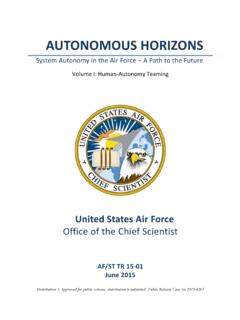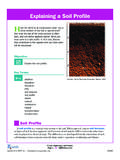Transcription of Juan Maldacena and Leonard Susskind …
1 Cool horizons for entangled black holesJuan Maldacena1and Leonard Susskind21 Institute for Advanced Study, Princeton, NJ 08540, USA2 Stanford Institute for Theoretical Physics and Department of Physics,Stanford University, Stanford, CA 94305-4060, USAA bstractGeneral relativity contains solutions in which two distant black holes are con-nected through the interior via a wormhole, or Einstein-Rosen bridge. These solu-tions can be interpreted as maximally entangled states of two black holes that forma complex EPR pair. We suggest that similar bridges might be present for moregeneral entangled the case of entangled black holes one can formulate versions of the AMPS(S)paradoxes and resolve them.
2 This suggests possible resolutions of the firewall para-doxes for more general [hep-th] 11 Jul 2013 Contents1 Introduction22 Einstein Rosen AdS Black Holes .. Cool horizons for entangled black holes .. Schwarzschild Black Holes .. Natural production of entangled black holes in the same spacetime .. Different bridges for different entangled states .. Bridges for less than maximal entanglement .. Growth of the Bridge ..133ER= No Superluminal Signals .. No Creation By LOCC .. the thermofield state .. Messages From Alice to Bob.. Clouds .. Hawking Radiation ..214 Implications for the AMPS Simple and Complex Operators.
3 A Laboratory Example .. Comments on flat space AMPS ..295 Comments on AMPSS and the Construction of the The AMPSS Experiment .. AMPSS like experiment for the eternalAdSblack hole .. contained inAand error correction .. Linearity .. A Comment on phases ..376 Conclusion39A Black hole pair creation in a magnetic field4311 IntroductionSpacetime locality is one of the cornerstones in our present understanding of locality we mean the impossibility of sending signals faster than the speed of be challenged both by quantum mechanics and by general mechanics gives rise to Einstein Podolsky Rosen (EPR) correlations [1], whilegeneral relativity allows solutions to the equations of motion that connect far away regionsthrough relatively short wormholes or Einstein Rosen bridges [2].
4 It has long beenunderstood that these two effects donotgive rise to real violations of locality. Onecannot use EPR correlations to send information faster than the speed of light. Similarly,Einstein Rosen bridges do not allow us to send a signal from one asymptotic region tothe other, at least when suitable positive energy conditions are obeyed [3, 4, 5]. This issometimes stated as saying that Lorentzian wormholes are not we will note that these two effects are actually connected. We argue that theEinstein Rosen bridge between two black holes is created by EPR-like correlations betweenthe microstates of the two black holes.
5 This is based on previous observations in [6, 10].We call this the ER = EPR relation. In other words, the ER bridge is a special kind ofEPR correlation in which the EPR correlated quantum systems have a weakly coupledEinstein gravity description. It is also special because the combined state is just oneparticular entangled state out of many possibilities. We note that black hole pair creationin a magnetic field naturally produces a pair of black holes in this state. It is verytempting to think thatanyEPR correlated system is connected by some sort of ERbridge, although in general the bridge may be a highly quantum object that is yet to beindependently defined.
6 Indeed, we speculate that even the simple singlet state of two spinsis connected by a (very quantum) bridge of this this article we explain the reasons for expecting such a connection. We also exploresome of the implications of this point of view for the black hole information problem, in itsAMPS(S)[11, 12] form. See [13, 14, 15] for some earlier work and [12] for a more completeset of references. See [16] for a proposal to describe interiors that is similar to what weare saying can be shown using the integrated null energy condition [4, 5], which is a correct condition inthe classical theory. It can be violated by a small amount in the quantum theory, but, as far as we know,not by enough to make wormholes traversable.
7 We will assume that wormholes remain un-traversable inthe quantum theory. If this were not true, the ER=EPR connection would be other work trying to connect two sided black holes with the AMPS paradox see [17].2 The first point is that two black holes that are far away but connected by an ERbridge provide an existence proof of a black hole that is maximally entangled with asecond distant system, but which nevertheless has a smooth horizon. On the other hand,AMPS [11] suggested that the smoothness of the interior will be destroyed once the blackhole becomes entangled with another system; the second system being the radiation intheir case.
8 If an observer collects the radiation, then, with a powerful enough quantumcomputer3, she could collapse it into a second black hole which is perfectly entangled withthe first. In addition, by operations solely on her side, she can put the pair of black holesin the special state that produces the smooth ER bridge. Thus we argue that the actionof a quantum computer on the radiation can produce a state where the horizon is the case of two very distant black holes which are entangled in the state thatproduces the ER bridge. Bob is stationed at one (the near black hole) and Alice is at theother (far black hole). Alice has a powerful quantum computer that can act on her blackhole.
9 Then it is possible for Alice to send messages to Bob through the Einstein-Rosenbridge. Bob cannot receive the messages as long as he is outside his horizon, but as soonas he passes through the horizon he can receive the messages. If Alice chooses, she cancreate a firewall at Bob s end. The original AMPS experiment can be restated as sendingsuch a message. We see that actions on the radiation are not innocuous; they can affectwhat Bob feels when he falls through the acting with her quantum computer on the radiation, Alice has created a very specialstate. What if she does not act on the radiation at all?. A naive picture is that theradiation would be connected by very quantum ER bridges to itself and also to the blackhole horizon.
10 Thus, whether the black hole horizon is smooth or not depends on how thesequantum bridges connect to form the big classical geometry outside the horizon of the firstblack hole. If we trust the equivalence principle, then we would conclude that the bridgeremains big and classical in the interior of the black hole. However, we do not have anindependent argument for its Einstein Rosen AdS Black HolesEinstein-Rosen bridges and their relation with entanglement is most rigorously understoodin the ADS/CFT framework. Consider the eternal AdS-Schwarzschild black hole whose3We are ignoring possible limits on quantum computation [18].3 Penrose diagram is shown in figure 1.
![arXiv:0706.3639v1 [cs.AI] 25 Jun 2007](/cache/preview/4/1/3/9/3/1/4/b/thumb-4139314b93ef86b7b4c2d05ebcc88e46.jpg)

![arXiv:1301.3781v3 [cs.CL] 7 Sep 2013](/cache/preview/4/d/5/0/4/3/4/0/thumb-4d504340120163c0bdf3f4678d8d217f.jpg)
![@google.com arXiv:1609.03499v2 [cs.SD] 19 Sep 2016](/cache/preview/c/3/4/9/4/6/9/b/thumb-c349469b499107d21e221f2ac908f8b2.jpg)









